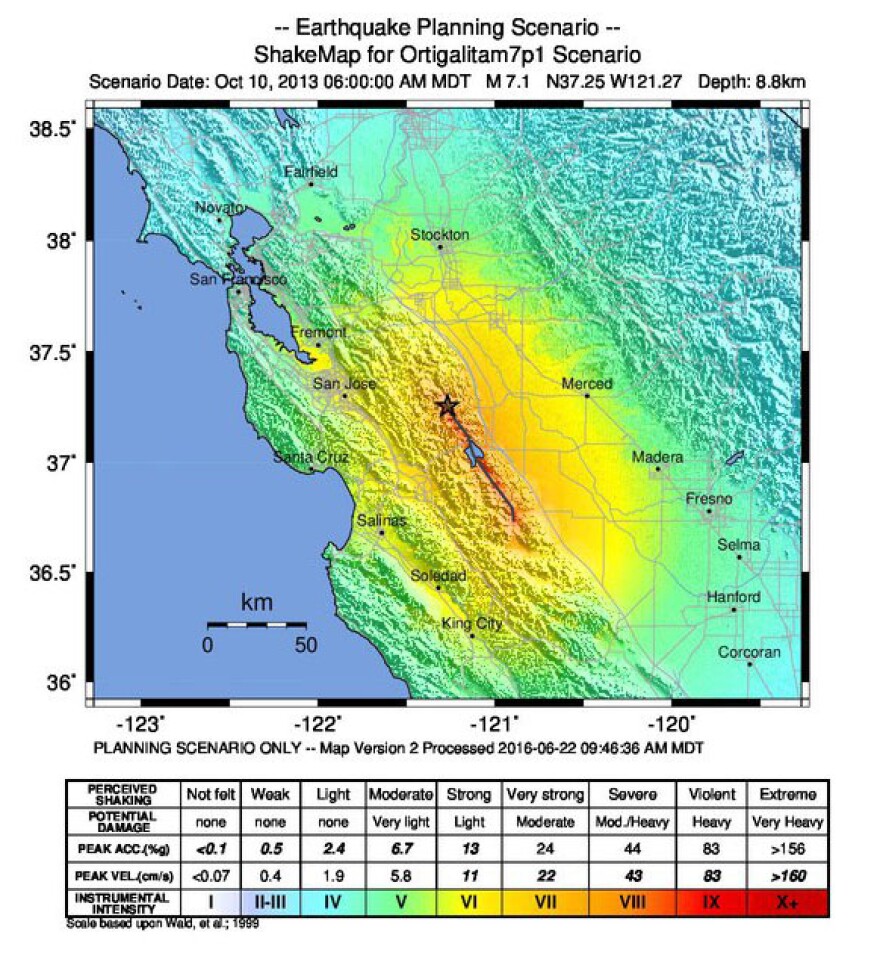Some of the same people who warned state leaders about the probability of Oroville Dam failing are now sounding the alarm at San Luis Reservoir in Merced County.
"It's a huge public safety issue. . . To south a little bit is Los Banos. There's 36,000 people. It would just tear through there." - Deirdre Des Jardin
It’s the first time since before the drought began that San Luis Reservoir in the hills west of Los Banos is nearly full at about 97 percent.
Thousands of drivers wrap around the man-made lake daily and many stop at the Romero Overlook Visitors Center to stretch their legs. From the site there’s a view of the dam, rolling hills and the valley floor.
That’s where I’m meeting Deirdre Des Jardin.
“You can see it’s pretty close to the top there,” Des Jardin says.
She analyzes policy for environmental groups and is concerned that an earthquake would greatly harm the dam holding back about 2 million acre feet of water. She wrote a blog post about her concerns earlier this year.

“The issue is that there’s the Ortigalita fault running right through this reservoir,” Des Jardin says.
She says if the Ortigalita Fault or others nearby like the San Andreas shift the risk of the dam failing is high. San Luis is about 28 miles from the San Andreas Fault and around 23 miles from the Calaveras-Hayward Fault. A study from 1999 shows the Ortigalita could generate an earthquake of a 7.1 magnitude.

“It’s a huge public safety issue,” says Des Jardin. “You can see down below us you can see O’Neill Forebay. To south a little bit is Los Banos. There’s 36,000 people. It would just tear through there.”
B.F. Sisk Dam is a 382 foot tall mound of clay, dirt, and rocks, much like Oroville. The dam is owned by the Bureau of Reclamation and operated and maintained by the Department of Water Resources. It’s unique in that water is pumped into it from the California Aqueduct and the Delta-Mendota Canal. This water comes from as far as Lake Shasta.
Today the Bureau of Reclamation is working on a project to keep the dam safe when earthquakes happen. Mynul Chowdhury is with Reclamation's Division of Safety of Dams. He says if it were to fail Interstate 5, farms, the California aqueduct and 200,000 people all sit in the water’s path.
“This failure is unlikely for any particular year, however the consequences of the dam failure could be very severe,” Chowdhury says.

He’s figuring out exactly what that probability would be in a corrective action study for the dam that may be released in May. It’s all part of a project that started in 2007 to make the dam structurally sound. Chowdhury says there’s enough cause to take any seismic activity seriously here.
In the early 1980’s a 1,100 foot portion of the dam crumbled due to constant wetting and drying of the clay the dam is made of. He says an earthquake could have worse effects.
“During seismic events sections of the dam could slump below the water line resulting in overtopping,” says Chowdhury. “Cracks also may develop. Water flowing through the cracks in the dam could erode the breach as well.”
To prevent this Chowdhury says his team would like to raise the dam by 15 to 20 feet and use a layer of sand to fill cracks if they form. He says solutions are scheduled to be proposed in May followed by an environmental review. He says the project should be complete by 2026 and will cost between $600 and $700 million. Chowdhury says he has a plan if any seepage occurs.
“Such as conducting heightened monitoring,” Chowdhury says. “We do the daily inspections when the reservoir exceeds elevation of about 544. We also have the emergency action plan which is current.”
"We didn't get anywhere until of course nature demonstrated if you run large quantities of water over a hillside a whole bunch of the hillside will tumble." - Ron Stork on his efforts to alert leaders about the potential disaster at Oroville Dam

In the meantime environmental watchdogs say they have a solution. They’d like the water level dropped 50 feet from the top of the dam. Chowdhury says that would reduce risk, but greatly decrease the amount of water stored in the reservoir and isn’t needed at the moment because of the other measures the Reclamation is taking under their dam safety guidelines.
He says a water restriction like that could go into effect during a construction stage of the project. This is isn’t the first time watchdogs like this have warned the state and feds about potential dam failures. In the early 2000’s Ron Stork with Friends of the River says he predicted the Oroville failure.
“We were stomped like a bug,” says Stork of DWR and Reclamation’s response to Stork then. “We didn’t get anywhere until of course nature demonstrated if you run large quantities of water over a hillside a whole bunch of the hillside will tumble.”
And now in light of that failure he’s glad Reclamation is taking potential seismic activity at San Luis Reservoir seriously. But he says to take a decade to fix the dam is way too long.
“They’re betting that the earthquake won’t happen this year when there’s a lot of water in San Luis,” Stork says. “Clearly the Oroville incident traumatically demonstrated that the risks are very real.”
And as Reclamation continues to study the dam at San Luis they’re working on three other studies to prevent dam failure in places like Folsom. They’re also evaluating 10 other dams for issues and the California Division of Safety of Dams is looking at least five for seismic safety across the state.




